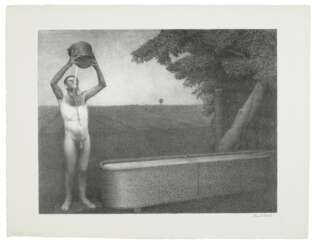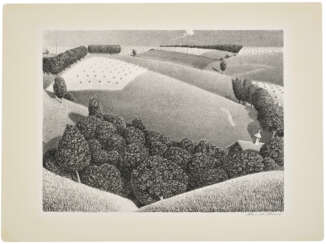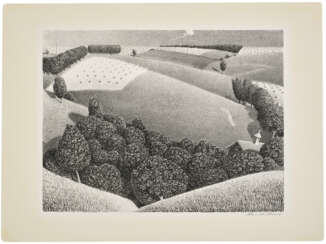грант вуд (1891 - 1942)
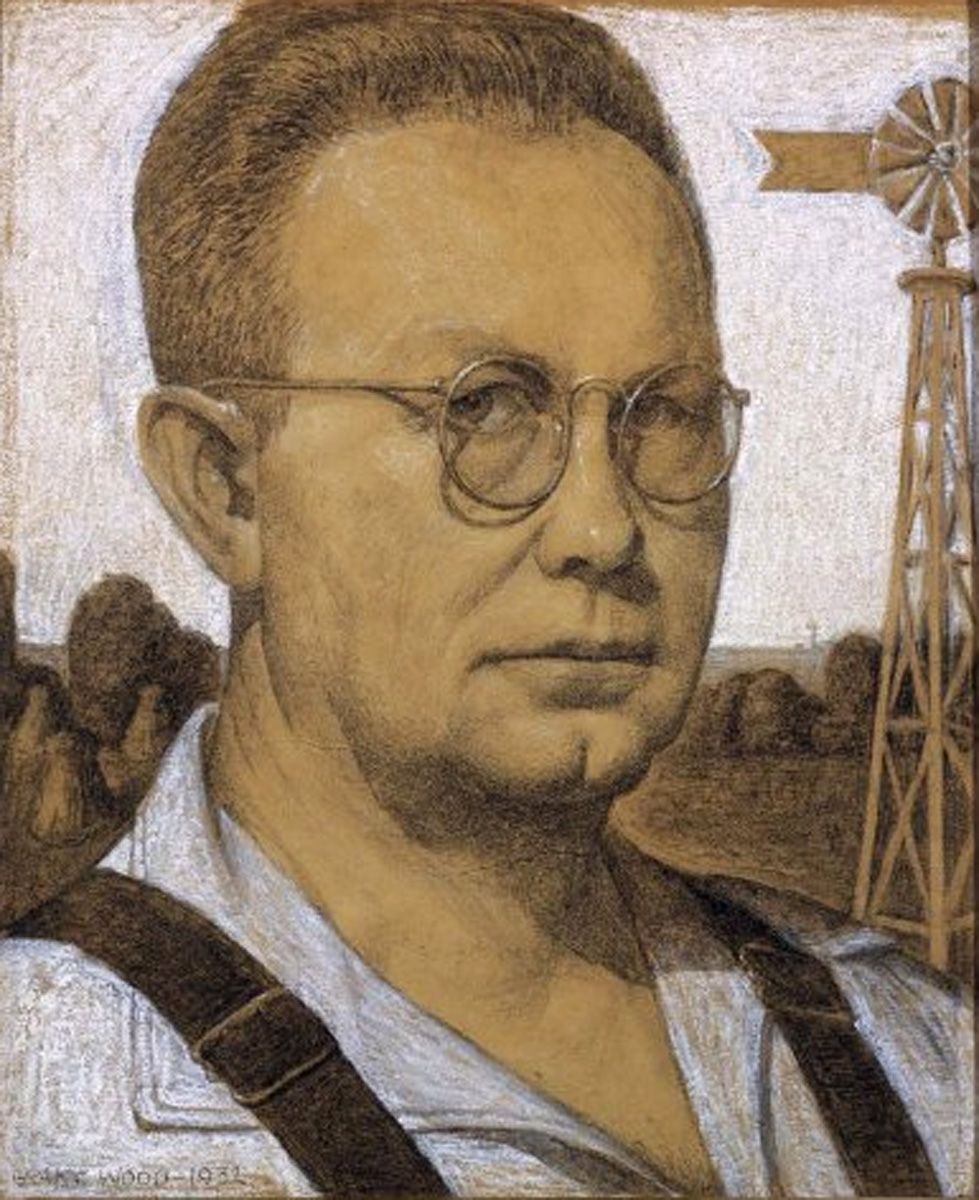
Grant Wood was an American painter, a notable figure in the Regionalism art movement, primarily known for his depiction of the rural American Midwest. Born on February 13, 1891, near Anamosa, Iowa, and passing away on February 12, 1942, in Iowa City, Iowa, Wood left a significant mark on American art with his focus on local themes and landscapes.
Wood's art style is characterized by its clear rejection of European abstraction, instead promoting a detailed and realistic portrayal of American life. This is most evident in his famous painting "American Gothic," which captures the essence of rural America through the figures of a farmer and his daughter against the backdrop of a Carpenter Gothic house. This painting, first exhibited in 1930 at the Art Institute of Chicago, not only won a prize but also brought Wood immediate national recognition.
In addition to painting, Wood was engaged in various artistic endeavors, including lithography and the design of decorative objects and furniture, reflecting his training as a craftsman and designer. His influence extended beyond his artworks, as he played a crucial role in fostering the Regionalism movement, helping other artists find positions and promoting a community-focused approach to art in the Midwest.
For art collectors and enthusiasts interested in Grant Wood's works or the broader scope of American Regionalism, staying informed about upcoming sales, exhibitions, and auction events is crucial. You can sign up for updates to ensure you never miss important developments related to Grant Wood and his impactful contributions to American art.


Grant Wood was an American painter, a notable figure in the Regionalism art movement, primarily known for his depiction of the rural American Midwest. Born on February 13, 1891, near Anamosa, Iowa, and passing away on February 12, 1942, in Iowa City, Iowa, Wood left a significant mark on American art with his focus on local themes and landscapes.
Wood's art style is characterized by its clear rejection of European abstraction, instead promoting a detailed and realistic portrayal of American life. This is most evident in his famous painting "American Gothic," which captures the essence of rural America through the figures of a farmer and his daughter against the backdrop of a Carpenter Gothic house. This painting, first exhibited in 1930 at the Art Institute of Chicago, not only won a prize but also brought Wood immediate national recognition.
In addition to painting, Wood was engaged in various artistic endeavors, including lithography and the design of decorative objects and furniture, reflecting his training as a craftsman and designer. His influence extended beyond his artworks, as he played a crucial role in fostering the Regionalism movement, helping other artists find positions and promoting a community-focused approach to art in the Midwest.
For art collectors and enthusiasts interested in Grant Wood's works or the broader scope of American Regionalism, staying informed about upcoming sales, exhibitions, and auction events is crucial. You can sign up for updates to ensure you never miss important developments related to Grant Wood and his impactful contributions to American art.


Grant Wood was an American painter, a notable figure in the Regionalism art movement, primarily known for his depiction of the rural American Midwest. Born on February 13, 1891, near Anamosa, Iowa, and passing away on February 12, 1942, in Iowa City, Iowa, Wood left a significant mark on American art with his focus on local themes and landscapes.
Wood's art style is characterized by its clear rejection of European abstraction, instead promoting a detailed and realistic portrayal of American life. This is most evident in his famous painting "American Gothic," which captures the essence of rural America through the figures of a farmer and his daughter against the backdrop of a Carpenter Gothic house. This painting, first exhibited in 1930 at the Art Institute of Chicago, not only won a prize but also brought Wood immediate national recognition.
In addition to painting, Wood was engaged in various artistic endeavors, including lithography and the design of decorative objects and furniture, reflecting his training as a craftsman and designer. His influence extended beyond his artworks, as he played a crucial role in fostering the Regionalism movement, helping other artists find positions and promoting a community-focused approach to art in the Midwest.
For art collectors and enthusiasts interested in Grant Wood's works or the broader scope of American Regionalism, staying informed about upcoming sales, exhibitions, and auction events is crucial. You can sign up for updates to ensure you never miss important developments related to Grant Wood and his impactful contributions to American art.
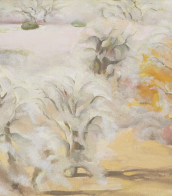

Grant Wood was an American painter, a notable figure in the Regionalism art movement, primarily known for his depiction of the rural American Midwest. Born on February 13, 1891, near Anamosa, Iowa, and passing away on February 12, 1942, in Iowa City, Iowa, Wood left a significant mark on American art with his focus on local themes and landscapes.
Wood's art style is characterized by its clear rejection of European abstraction, instead promoting a detailed and realistic portrayal of American life. This is most evident in his famous painting "American Gothic," which captures the essence of rural America through the figures of a farmer and his daughter against the backdrop of a Carpenter Gothic house. This painting, first exhibited in 1930 at the Art Institute of Chicago, not only won a prize but also brought Wood immediate national recognition.
In addition to painting, Wood was engaged in various artistic endeavors, including lithography and the design of decorative objects and furniture, reflecting his training as a craftsman and designer. His influence extended beyond his artworks, as he played a crucial role in fostering the Regionalism movement, helping other artists find positions and promoting a community-focused approach to art in the Midwest.
For art collectors and enthusiasts interested in Grant Wood's works or the broader scope of American Regionalism, staying informed about upcoming sales, exhibitions, and auction events is crucial. You can sign up for updates to ensure you never miss important developments related to Grant Wood and his impactful contributions to American art.


Grant Wood was an American painter, a notable figure in the Regionalism art movement, primarily known for his depiction of the rural American Midwest. Born on February 13, 1891, near Anamosa, Iowa, and passing away on February 12, 1942, in Iowa City, Iowa, Wood left a significant mark on American art with his focus on local themes and landscapes.
Wood's art style is characterized by its clear rejection of European abstraction, instead promoting a detailed and realistic portrayal of American life. This is most evident in his famous painting "American Gothic," which captures the essence of rural America through the figures of a farmer and his daughter against the backdrop of a Carpenter Gothic house. This painting, first exhibited in 1930 at the Art Institute of Chicago, not only won a prize but also brought Wood immediate national recognition.
In addition to painting, Wood was engaged in various artistic endeavors, including lithography and the design of decorative objects and furniture, reflecting his training as a craftsman and designer. His influence extended beyond his artworks, as he played a crucial role in fostering the Regionalism movement, helping other artists find positions and promoting a community-focused approach to art in the Midwest.
For art collectors and enthusiasts interested in Grant Wood's works or the broader scope of American Regionalism, staying informed about upcoming sales, exhibitions, and auction events is crucial. You can sign up for updates to ensure you never miss important developments related to Grant Wood and his impactful contributions to American art.



